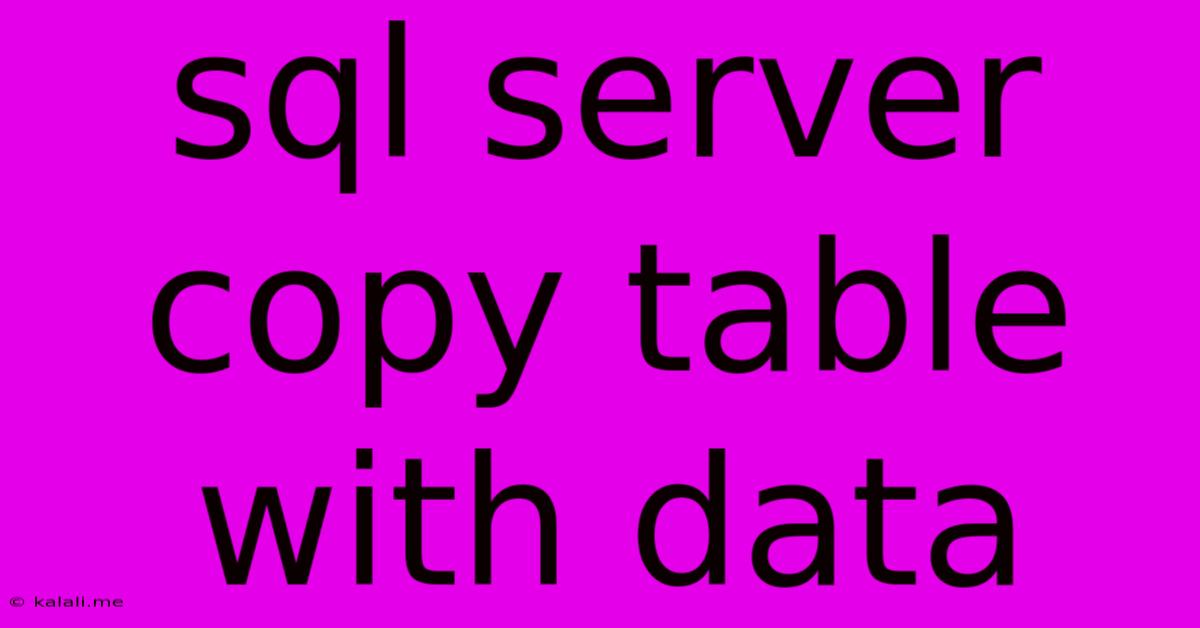Sql Server Copy Table With Data
Kalali
Jun 05, 2025 · 3 min read

Table of Contents
SQL Server: Copying Tables and Data – A Comprehensive Guide
Copying tables and their data in SQL Server is a common task, crucial for various database management operations, from backups and data warehousing to testing and development. This comprehensive guide explores different methods for efficiently copying SQL Server tables with their data, highlighting their strengths and weaknesses to help you choose the best approach for your specific needs. We'll cover both simple and more complex scenarios.
Methods for Copying Tables with Data in SQL Server
Several techniques exist for replicating SQL Server tables, each with its own pros and cons. The optimal method depends on factors such as the size of the table, the complexity of the data, and performance requirements.
1. SELECT INTO Statement
This is the simplest and often the fastest method for copying smaller tables. The SELECT INTO statement creates a new table and populates it with data from a source table based on the specified SELECT query.
SELECT * INTO NewTable FROM OldTable;
This copies all columns and rows from OldTable to NewTable. You can add a WHERE clause to copy only specific rows.
Advantages:
- Simple and easy to understand.
- Generally fast for smaller datasets.
Disadvantages:
- Can be slow for large tables.
- Doesn't handle indexes or constraints automatically. These need to be recreated manually on the new table.
- Locks the source table during the copy operation.
2. INSERT INTO ... SELECT Statement
This method offers more flexibility than SELECT INTO, especially when dealing with large tables or needing to perform data transformations.
INSERT INTO NewTable (Column1, Column2, Column3)
SELECT ColumnA, ColumnB, ColumnC FROM OldTable;
This allows you to selectively copy specific columns and perform data manipulation during the copy process.
Advantages:
- More flexible than
SELECT INTO. - Allows selective column copying and data transformation.
- Can handle larger datasets more efficiently than
SELECT INTO, especially with proper indexing.
Disadvantages:
- More complex than
SELECT INTO. - Requires pre-existing
NewTablewith appropriate schema. - Can be resource-intensive for extremely large tables.
3. Using OPENROWSET (For External Data)
If you need to copy data from an external source or another database server, OPENROWSET is a powerful option.
INSERT INTO NewTable (Column1, Column2, Column3)
SELECT ColumnA, ColumnB, ColumnC
FROM OPENROWSET('BULK', 'C:\data.csv',
FORMAT = 'CSV', FIELDTERMINATOR = ',', ROWTERMINATOR = '\n');
Advantages:
- Handles data from various external sources (CSV, text files, etc.).
- Useful for data migration from other systems.
Disadvantages:
- Requires appropriate permissions and file access.
- Can be slower than other methods depending on the data source.
4. Database Mirroring or Replication
For high-availability and disaster recovery, database mirroring or replication provide robust solutions for creating near real-time copies of your entire database, including tables and data. These are advanced techniques beyond the scope of simple table copying.
Advantages:
- High availability and disaster recovery.
- Near real-time data synchronization.
Disadvantages:
- More complex to set up and manage.
- Increased resource consumption.
5. Using T-SQL Stored Procedures
For complex scenarios involving multiple tables or data manipulation, creating a custom stored procedure provides greater control and maintainability.
Advantages:
- Highly customizable and reusable.
- Ideal for complex scenarios.
Disadvantages:
- Requires more development effort.
Choosing the Right Method
The best method for copying tables and data in SQL Server depends on your specific requirements:
- Small tables:
SELECT INTOis usually sufficient. - Larger tables requiring selective column copy:
INSERT INTO ... SELECTis preferable. - External data sources:
OPENROWSETis the appropriate choice. - High availability and disaster recovery: Database mirroring or replication is necessary.
- Complex scenarios: A custom T-SQL stored procedure is recommended.
Remember to always back up your database before performing any data manipulation operations. Thorough testing on a development or staging environment is also crucial to avoid unintended consequences in your production database. Consider indexing your new table for optimal performance after the copy operation is complete.
Latest Posts
Latest Posts
-
Why Couldnt Moses Enter The Promised Land
Jun 07, 2025
-
Why Does Nasdaq Not Publish Order Book Anymore
Jun 07, 2025
-
What Is A Naturalized Or Derived Citizen
Jun 07, 2025
-
Where Can I Watch Boku No Pico
Jun 07, 2025
-
How Thick Should Concrete Be For A Driveway
Jun 07, 2025
Related Post
Thank you for visiting our website which covers about Sql Server Copy Table With Data . We hope the information provided has been useful to you. Feel free to contact us if you have any questions or need further assistance. See you next time and don't miss to bookmark.